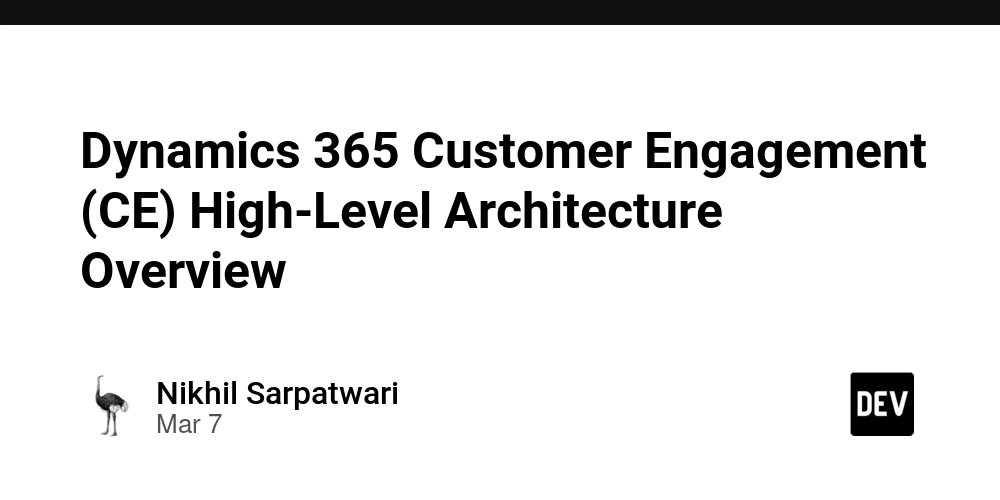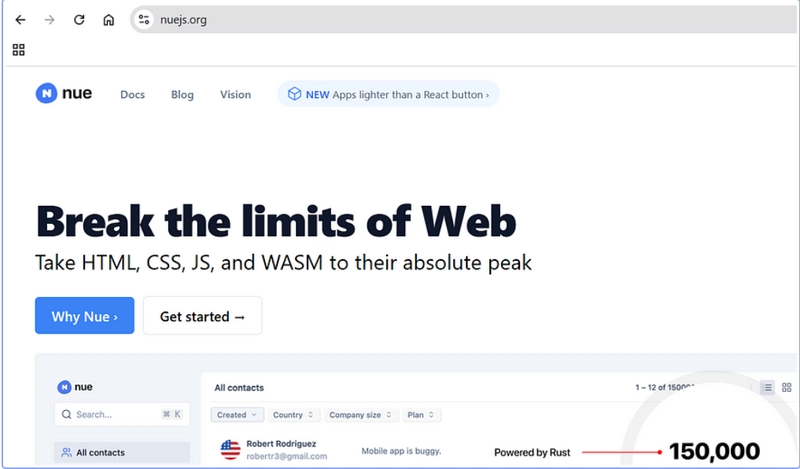Dynamics 365 Customer Engagement (CE) High-Level Architecture Overview
In today's rapidly evolving digital landscape, Dynamics 365 Customer Engagement (CE) plays a critical role in helping businesses streamline their customer-centric processes. As a Solution Architect, understanding the high-level architecture of Dynamics 365 CE is essential to design scalable, secure, and efficient solutions that meet business needs. This blog provides a quick high-level overview of the Dynamics 365 CE architecture, breaking down its core layers and how they work together to deliver enterprise-grade applications. Dynamics 365 CE Architecture Overview At a high level, the Dynamics 365 CE architecture is composed of several layers, each responsible for different aspects of the system: Presentation Layer (User Interface) The Presentation Layer is how users interact with the system through various applications and devices. Key Components: Model-Driven Apps: Unified interface for standard applications like Sales and Customer Service. Canvas Apps: Custom applications tailored to business-specific UI requirements. Power Pages (Portals): External-facing websites for customer self-service. Microsoft Teams & Outlook Integration: Seamless collaboration with productivity tools. Application Layer The Application Layer includes Dynamics 365 apps and Power Platform services that deliver out-of-the-box functionality. Key Components: Dynamics 365 Sales, Customer Service, and Customer Insights - Journeys Power Automate for workflow automation Copilot Studio for conversational AI experiences Business Process Flows to guide users through business processes. Business Logic Layer This layer defines how business rules and processes are executed across the system. Key Components: Plugins: Custom C# code for complex business logic Business Rules: No-code validations and automation Process Flows: Visual business process guidance Power Automate: Event-driven automation across systems Custom APIs: Reusable business logic endpoints. Data Layer At the heart of Dynamics 365 CE is Microsoft Dataverse, a secure and scalable cloud-based data platform. Key Components: Standard and custom tables (entities) Virtual Tables for external data access Auditing for compliance and change tracking Data import and export capabilities. Integration Layer Modern enterprise systems rarely operate in isolation. Dynamics 365 CE offers several integration options. Key Components: Web API & Organization Service for external applications Azure Service Bus for event-driven integrations Power Platform Connectors for seamless third-party integrations Custom APIs and Azure Functions for custom integrations. Security Layer Security is a fundamental aspect of any enterprise system. Dynamics 365 CE provides multi-layered security mechanisms. Key Components: Role-Based Security: Granular access based on user roles Field-Level Security: Protect sensitive data Row-Level Security (Record Sharing): Control who can access which records Azure AD & OAuth for authentication and authorization. Administration & Monitoring System administration and monitoring ensure the solution remains stable, secure, and compliant. Key Components: Power Platform Admin Center for environment management Solution Management for version control and deployments Application Insights and Dataverse Auditing for telemetry. Extensibility Dynamics 365 CE is highly customizable to meet unique business needs. Key Components: Power Apps Component Framework (PCF) for custom UI components Custom APIs for reusable logic XrmToolBox plugins for advanced administrative tools Conclusion Understanding the high-level architecture of Dynamics 365 Customer Engagement is essential for Solution Architects to design scalable and future-proof solutions. Whether you're integrating with external systems, building custom plugins, or automating business processes — Dynamics 365 CE provides a robust framework to bring your ideas to life. As I continue my journey exploring the Dynamics 365 ecosystem, I'll be sharing more technical deep dives and best practices. Stay tuned for future posts.

In today's rapidly evolving digital landscape, Dynamics 365 Customer Engagement (CE) plays a critical role in helping businesses streamline their customer-centric processes. As a Solution Architect, understanding the high-level architecture of Dynamics 365 CE is essential to design scalable, secure, and efficient solutions that meet business needs.
This blog provides a quick high-level overview of the Dynamics 365 CE architecture, breaking down its core layers and how they work together to deliver enterprise-grade applications.
Dynamics 365 CE Architecture Overview
At a high level, the Dynamics 365 CE architecture is composed of several layers, each responsible for different aspects of the system:
Presentation Layer (User Interface)
The Presentation Layer is how users interact with the system through various applications and devices.
Key Components:
Model-Driven Apps: Unified interface for standard applications like Sales and Customer Service.
Canvas Apps: Custom applications tailored to business-specific UI requirements.
Power Pages (Portals): External-facing websites for customer self-service.
Microsoft Teams & Outlook Integration: Seamless collaboration with productivity tools.
Application Layer
The Application Layer includes Dynamics 365 apps and Power Platform services that deliver out-of-the-box functionality.
Key Components:
Dynamics 365 Sales, Customer Service, and Customer Insights - Journeys
Power Automate for workflow automation
Copilot Studio for conversational AI experiences
Business Process Flows to guide users through business processes.
Business Logic Layer
This layer defines how business rules and processes are executed across the system.
Key Components:
Plugins: Custom C# code for complex business logic
Business Rules: No-code validations and automation
Process Flows: Visual business process guidance
Power Automate: Event-driven automation across systems
Custom APIs: Reusable business logic endpoints.
Data Layer
At the heart of Dynamics 365 CE is Microsoft Dataverse, a secure and scalable cloud-based data platform.
Key Components:
Standard and custom tables (entities)
Virtual Tables for external data access
Auditing for compliance and change tracking
Data import and export capabilities.
Integration Layer
Modern enterprise systems rarely operate in isolation. Dynamics 365 CE offers several integration options.
Key Components:
Web API & Organization Service for external applications
Azure Service Bus for event-driven integrations
Power Platform Connectors for seamless third-party integrations
Custom APIs and Azure Functions for custom integrations.
Security Layer
Security is a fundamental aspect of any enterprise system. Dynamics 365 CE provides multi-layered security mechanisms.
Key Components:
Role-Based Security: Granular access based on user roles
Field-Level Security: Protect sensitive data
Row-Level Security (Record Sharing): Control who can access which records
Azure AD & OAuth for authentication and authorization.
Administration & Monitoring
System administration and monitoring ensure the solution remains stable, secure, and compliant.
Key Components:
Power Platform Admin Center for environment management
Solution Management for version control and deployments
Application Insights and Dataverse Auditing for telemetry.
Extensibility
Dynamics 365 CE is highly customizable to meet unique business needs.
Key Components:
Power Apps Component Framework (PCF) for custom UI components
Custom APIs for reusable logic
XrmToolBox plugins for advanced administrative tools
Conclusion
Understanding the high-level architecture of Dynamics 365 Customer Engagement is essential for Solution Architects to design scalable and future-proof solutions. Whether you're integrating with external systems, building custom plugins, or automating business processes — Dynamics 365 CE provides a robust framework to bring your ideas to life.
As I continue my journey exploring the Dynamics 365 ecosystem, I'll be sharing more technical deep dives and best practices. Stay tuned for future posts.











































































































































































![[The AI Show Episode 142]: ChatGPT’s New Image Generator, Studio Ghibli Craze and Backlash, Gemini 2.5, OpenAI Academy, 4o Updates, Vibe Marketing & xAI Acquires X](https://www.marketingaiinstitute.com/hubfs/ep%20142%20cover.png)




























































































































![[DEALS] The Premium Learn to Code Certification Bundle (97% off) & Other Deals Up To 98% Off – Offers End Soon!](https://www.javacodegeeks.com/wp-content/uploads/2012/12/jcg-logo.jpg)


![From drop-out to software architect with Jason Lengstorf [Podcast #167]](https://cdn.hashnode.com/res/hashnode/image/upload/v1743796461357/f3d19cd7-e6f5-4d7c-8bfc-eb974bc8da68.png?#)








































































































.png?#)


































_Christophe_Coat_Alamy.jpg?#)
.webp?#)
 (1).webp?#)






































































































![Apple Considers Delaying Smart Home Hub Until 2026 [Gurman]](https://www.iclarified.com/images/news/96946/96946/96946-640.jpg)
![iPhone 17 Pro Won't Feature Two-Toned Back [Gurman]](https://www.iclarified.com/images/news/96944/96944/96944-640.jpg)
![Tariffs Threaten Apple's $999 iPhone Price Point in the U.S. [Gurman]](https://www.iclarified.com/images/news/96943/96943/96943-640.jpg)
































































































































